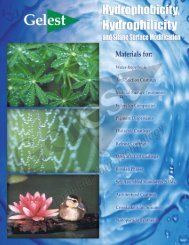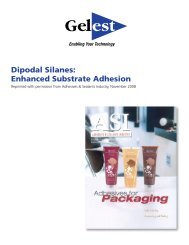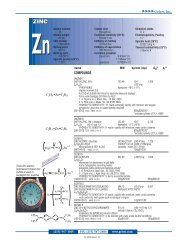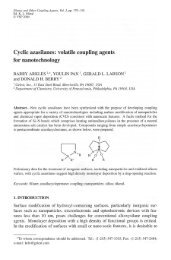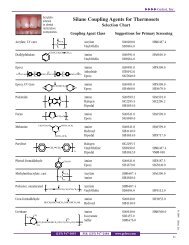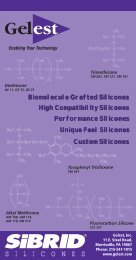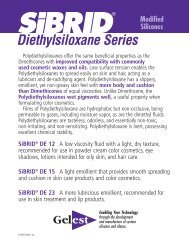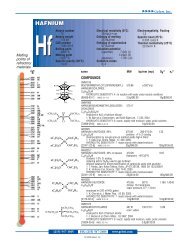You also want an ePaper? Increase the reach of your titles
YUMPU automatically turns print PDFs into web optimized ePapers that Google loves.
<strong>PHASE</strong> NEWS<br />
Vol. 1 No. 2<br />
Contents<br />
Polar and Ionic Phases — Technique Tips<br />
Branched Silanes — An Update<br />
Product Shorts<br />
Polar and Ionic Phases — Technique Tips<br />
Of all the commonly employed bonded phases, polar and ionic phases provide the<br />
greatest challenge for reproducibility. These phases fall into three main classes:<br />
Cyano Phases<br />
Cationic Phases<br />
Anionic Phases<br />
Each category has separate demands for achieving batch to batch consistency.<br />
Cyano Phases<br />
The most widely used cyano phases are derived from cyanopropylchlorosilanes,<br />
most usually cyanopropyltrichlorosilane or cyanopropyldimethylchlorosilane. The initial<br />
expectation is that the bonding proceeds through a simple displacement reaction.<br />
Problems can occur due to the introduction of water to the reaction mixture. More<br />
often than not the water is deliberately intro-duced because it serves to polymerize the<br />
siloxane phase over the surface to increase the total amount of bonded phase. Water and<br />
hydrogen chloride react readily with the cyano group forming amides and carboxylic<br />
acids.<br />
A random examination of bonded cyanophases used in both SPE and HPLC showed<br />
clear evidence of the presence of amides and carboxylates in over half of the samples<br />
tested. In two cases there was no evidence of the presence of cyano groups.
Action Points:<br />
1.) If the bonded phase is working well in an established method, make sure your<br />
bonding method is reproducible. Put controls on the moisture content of the bonding<br />
solvent and support. Run FTIR DRIFT analysis to determine the nature of the bonded<br />
polar phase.<br />
2.) If the bonded phase does not yield reproducible results, try the following: Put<br />
controls on the moisture content of the bonding solvent and support. During the bonding<br />
step apply a slow nitrogen sparge directly into the bonding reaction media; this removes<br />
HC1 as it is formed.<br />
3.) If a new phase is being created, methoxy or dimethylamino versions of the older<br />
chlorosilanes are frequently selected. These alternatives eliminate the formation of<br />
carboxylates. Methoxysilanes bond more slowly than the chlorosilanes.<br />
Dimethylaminosilanes react at rates similar to the chlorosilanes but are more costly.<br />
Other trends in cyanosilanes<br />
Cyanopropylsilanes are ultimately prepared by a cyanide chemistry route.<br />
Environmental and safety considerations for these low volume chemicals is expected to<br />
result in significant price pressure. Cyanoethyl and cyanobutyl silanes, prepared by<br />
electrochemical synthesis, appear to be good alternatives.<br />
Cationic Phases<br />
Cationic phases are prepared either by direct bonding of quaternary amines or by<br />
post-bonding conversion of aminoalkylsilanes or chloroalkyl silanes. Direct bonding of<br />
quaternary silanes is usually reproducible. Post-bonding conversion allows greater<br />
latitude in creating unique bonded phases, but process control is more critical.<br />
Cationic phases prepared by post-bonding conversion can suffer from poor<br />
stability due to the initial aminoalkylsilane bonding step. Frequently this is due to<br />
methods in which there is a hard acid pretreatment of the support. What occurs is an<br />
inverted, hydrolytically unstable, deposition of the silane.<br />
Proper orientation of aminosilanes is usually assured by deposition from aqueous alcohol,<br />
adjusting the water-alcohol-media pH with-in the range of 4.5-7.4 before silane<br />
introduction.<br />
Cationic phases prepared by post-bonding conversion can exhibit variable<br />
retentions due to byproduct reactions during quaternization.
A balance has to be achieved between driving the quaternization reaction, which<br />
usually requires a minimum temperature of 80°, and the elimination reaction which<br />
becomes significant at temperatures >110° for quaternary chlorides.<br />
Anionic Phases<br />
The most common anionic phases are derived from the chlorosulfonation of<br />
aromatic silanes. Methods which involve the post-bonding conversion of phenyl groups<br />
suffer significant reproducibility problems if they are derived from phenyltrichlorosilane.<br />
On the other hand, the reaction proceeds in relatively high yield if there is a spacer group<br />
between the electropositive silicon and the aromatic group.<br />
Direct bonding of cationic and anionic phases proceeds under typical bonding conditions<br />
in solvents ranging from methanol to toluene. There is a strong plus in reproducibility<br />
compared to post-bonding conversion. Only a limited number of silanes is available and<br />
customization is usually achieved by simultaneous bonding with C18 or other silanes.<br />
Branched Silanes — A Progress Report<br />
C23 Branched Silane Introduced<br />
The drive to 100% aqueous media and higher bonding load for preparative<br />
separations has led to the introduction of tricocylmethyldichlorosilane. It shares the<br />
features of an asymmetric hydrophobic group and steric shielding depicted below.<br />
The increasing number of acidic<br />
analytes and the drive to aqueous media<br />
have generated a high level of interest in<br />
finding a way to create hydrophobic phases<br />
without the limitations of C18. Polar<br />
solvents are thought to induce phase (bed)<br />
collapse, a process which may be caused by<br />
self-association or crystallization of the<br />
long regular C18 chains.<br />
Heptacocyldimethylchlorosilane was introduced<br />
in 1999 as the first example of a new<br />
approach to generate more versatile<br />
hydrophobic phases for high pressure and<br />
preparative liquid chromatography. The<br />
C27 column has the advantage of longer<br />
term retention stability of analytes compared to conventional C18 phases with straight<br />
aqueous mobile phases. The branched molecular structure of the C27 silane appears to<br />
minimize the phase collapse phenomenon. However, on extended exposure of the C27<br />
phase to aqueous medium, a progressive, small loss of retention was observed. It was<br />
hypothesized that by reducing the chain length of the silane the phase collapse
phenomenon could be minimized or even eliminated. To test this hypothesis, a C23<br />
silane, (tricocylmethyl)dimethylchlorosilane was prepared and bound to 5 micron silica.<br />
A separation of alkyl carboxylic acids on the C23 column is shown in Figure 2. In a 120<br />
hour (5 day) experiment there was a 5% loss of retention, compared to a 50% loss of<br />
retention for the C27 column under the same conditions is shown in Figure 3. There was<br />
a total loss of retention with a C18 column in 15 hours. Unlike the C18 column, the C23<br />
column retention can be regained with a 5 minute wash with methanol.
SIC2266.0<br />
1 3-(CHLORODIMETHYLSILYLMETHYL)HEPTACOSANE,<br />
95%<br />
10g/$110.00<br />
SIC2266.5<br />
11-(CHLORODIMETHYLSILYLMETHYL)TRICOSANE<br />
10g/$95.00<br />
PRODUCT SHORTS<br />
Aldehyde Functional Silanes<br />
The ability of aldehydes to form Schiff bases on reaction with amines leads to a<br />
variety of interesting applications for immobi-lization of biologically active molecules.<br />
SIT8185.3<br />
TRIETHOXYSILYLBUTYRALDEHYDE, 90%<br />
contains isomers 10g/$60.00<br />
Search WWW.<strong>Gelest</strong> Com the Interactive Web-Site<br />
<strong>Gelest</strong>, <strong>Inc</strong>. offers over 500 chemicals and polymers directed toward surface<br />
modification. Our interactive web-site allows you to analyze listings of products by<br />
application or by functionality. Our advanced search function allows you to draw a<br />
chemical structure for a product search. Every <strong>Gelest</strong> material has technical data and<br />
reference notations on the search results. You can contact <strong>Gelest</strong> through e-mail or by<br />
telephone for inquiries regarding custom sysnthesis.<br />
Phase News is published by <strong>Gelest</strong> <strong>Inc</strong>. <strong>Gelest</strong> is a leading supplier of materials for the<br />
preparation of bonded and stationary phases. With over 500 chemicals and polymers<br />
directed toward surface modification, <strong>Gelest</strong> is able to participate at all levels of research,<br />
development and commercialization.<br />
Copyright © 2000 by<br />
<strong>Gelest</strong> <strong>Inc</strong>.<br />
612 William Leigh Drive<br />
Tullytown, PA 19007<br />
Phone: (215) 547-1015<br />
FAX: (215) 547-2484<br />
Web: www.gelest.com
CYANOSILANES<br />
SIC2437.0<br />
(3-CYANOBUTYL)METHYLDICHLOROSILANE<br />
[71550-62-4] TSCA HMIS: 3-2-1-X<br />
25g/$40.00 100g/$130.00<br />
SIC2438.0<br />
(3-CYANOBUTYL)TRICHLOROSILANE<br />
[163155-56-4] HMIS: 3-2-1-X<br />
25g/$39.00 100g/$127.00<br />
SIC2445.0<br />
2-CYANOENIYLTRIETHOXYSILANE<br />
[919-31-3] TSCA HMIS: 2-2-0-X<br />
25g/$15.00 100g/$49.00<br />
SIC2446.0<br />
2 -CYANOETHYLTRIMETHOXYSILANE<br />
[2526-62-7] HMIS: 3-2-1-X<br />
25g/$40.00 100g/$130.00<br />
SIC2452.0<br />
3-CYANOPROPYLDIMETHYLCHLOROSILANE<br />
[18156-15-5] TSCA HMIS: 3-2-1-X<br />
25v$34.00 100k$110.00<br />
SIC2453.0<br />
3-CYANOPROPYLMETHYLDICHLOROSILANE<br />
[1190-16-5] TSCA HMIS: 3-2-1-X<br />
25g/$35.00 100g/$114.00<br />
SIC2453.5<br />
3-CYANOPROPYLMETHYLDIMETHOXYSILANE<br />
HMIS: 3-2-1-X<br />
5.0g/$27.00 25g/$108.00<br />
SIC2453.7<br />
3-CYANOPROPYLPHENYLDICHLOROSILANE<br />
[1078-96-2] TSCA HMIS: 3-2-1-X<br />
10g/$94.00<br />
SIC2454.0<br />
3-CYANOPROPYLTRICHLOROSILANE<br />
[1071-27-8] TSCA HMIS: 3-2-1-X<br />
25g/$22.00 100g/$72.00<br />
SIC2455.0<br />
3-CYANOPROPYLTRIETHOXYSILANE<br />
[1067-47-6] TSCA HMIS: 3-2-1-X<br />
25g/$30.00 100g/$94.00<br />
SIC2456.0<br />
3-CYANOPROPYLTRIMETHOXYSILANE<br />
[55453-24-2] TSCA-L HMIS: 3-2-1-X<br />
10g/$30.00 50g/$140.00<br />
SIC2456.5<br />
11-CYANOUNDECYLTRIMETHOXYSILANE<br />
HMIS: 2-1-0-X<br />
5.0g/$146.00<br />
CATIONIC SILANES<br />
SID3392.0<br />
N,N-DIDECYL-N-METHYL-N-(3-TRIMETHOXY-<br />
SILYLPROPYL)-AMMONIUM CHLORIDE, 42% in<br />
methanol<br />
[68959-20-6] TSCA HMIS: 3-4-0-X 25g/$46.00<br />
SIO6620.0<br />
OCTADECYLDIMETHYL(3-TRIMETHOXY-<br />
SILYLPROPYL)-AMMONIUM CHLORIDE, 60% in<br />
methanol<br />
[27668-52-6] TSCA HMIS: 3-4-0-X<br />
25g/$24.00 2kg/$280.00<br />
SIT8395.0<br />
N-(TRIMETHOXYSILYLETHYL)BENZYL-N,N,N,-<br />
TRIMETHYLAMMONIUM CHLORIDE, 60% in<br />
methanol<br />
HMIS: 3-3-1-X 25g/$80.00<br />
SIT8415.0<br />
N-TRIMETHOXYSILYLPROPYL-N,N,N-<br />
TRIMETHYL-<br />
AMMONIUM CHLORIDE (50% in methanol)<br />
[35141-36-7] TSCA HMIS: 2-4-1-X<br />
5g/$17.00 400g/$210.00<br />
ANIONIC SILANES<br />
SIC2415.0<br />
2-(4-CHLOROSULFONYLPHENYL)ETHYL-<br />
TRICHLOROSILANE,<br />
50% in methylene chloride<br />
[79793-00-3] TSCA HMIS: 4-2-2-X<br />
25g/$45.00 100g/$148.00<br />
SIC2415.4<br />
2-(4-CHLOROSULFONYLPHENYL)ETHYL-<br />
TRICHLOROSILANE, 50% in toluene<br />
[79793-00-3] TSCA HMIS: 4-4-2-X<br />
25g/$49.00 100g/$159.00<br />
SIC2417.0<br />
2-(4-CHLOROSULFONYLPHENYL)ETHYL-<br />
TRIMETHOXYSILANE, 50% in methylene<br />
chloride<br />
HMIS: 3-2-1-X<br />
25g/$68.00 100g/$221.00<br />
SIT8378.3<br />
3-(TRIHYDROXYSILYL)-1-PROPANE-<br />
SULFONIC ACID, 45-50% in water<br />
[70942-24-4] TSCA HMIS: 3-0-0-X<br />
25g/$48.00



